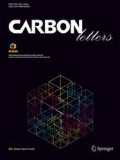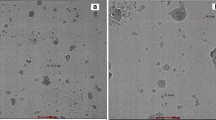Abstract
In this study, we report a controlled one-pot green synthesis of multiwalled carbon nanotubes (MWCNTs) via pyrolysis of sustainable agriculture waste (chickpea peel) at 400 °C in aqueous medium. These MWCNTs demonstrated 7.0 nm diameter, 0.28 nm graphitic spacing with carbonyl, hydroxyl, and carboxylic acid functionality. The D band (presence of sp3 defects) and G band (E2g mode of graphite) at 1350 cm−1 and 1580 cm−1 originated in Raman spectrum, respectively. The prepared MWCNTs showed blue fluorescence with 10% fluorescence quantum yield in aqueous medium. The MWCNTs showed triple exponential decay characteristics with an average fluorescence lifetime of 4.7 ns. The synthesized MWCNTs revealed a consistent fluorescence in the cytoplasm of 22RV1 human prostate carcinoma cell line without exerting any sign of cytotoxicity. The MWCNTs also exhibited remarkable cytocompatibility in human immortalized prostate epithelial RWPE1 cells.
Graphic abstract








Similar content being viewed by others
References
Jorio A, Dresselhaus G (2006) Advanced topics in the synthesis, structure. Springer Publishing House, Berlin, p 101
Tuaev X, Paraknowitsch JP, Illgen R, Thomas A, Strasser P (2012) Nitrogen-doped coatings on carbon nanotubes and their stabilizing effect on Pt nanoparticles. Phys Chem Chem Phys 14:6444–6447
Hatton RA, Miller AJ, Silva SRP (2008) Carbon nanotubes: a multi-functional material for organic optoelectronics. J Mater Chem 18:1183–1192
Wen J, Xu Y, Li H et al (2015) Recent applications of carbon nanomaterials in fluorescence biosensing and bioimaging. Chem Commun 51:11346–11358
Lota G, Fic K, Frackowiak E (2011) Carbon nanotubes and their composites in electrochemical applications. Energy Environ Sci 4:1592–1605
Liang C, Diao S, Wang C, Gong H, Liu T, Hong G, Shi X, Dai H, Liu Z (2014) Tumor metastasis inhibition by imaging-guided photothermal therapy with single-walled carbon nanotubes. Adv Mater 56:5646–5652
Harrison BS, Atala A (2007) Carbon nanotube applications for tissue engineering. Biomaterials 28:344–352
Hammel E, Tang X, Trampert M, Schmitt T, Mauthner K, Eder A, Pötschke P (2004) Carbon nanofibers for composite applications. Carbon 42:1153–1158
Iizumi Y, Yudasaka M, Kim J, Sakakita H, Takeuchi T, Okazaki T (2018) Oxygen-doped carbon nanotubes for near-infrared fluorescent labels and imaging probes. Sci Rep 8:6272
Boghossian AA, Zhang J, Barone PW, Reuel NF, Kim JH, Heller DA, Ahn JH, Hilmer AJ, Rwei A, Arkalgud JR, Zhang CT, Strano MS (2011) Near-infrared fluorescent sensors based on single-walled carbon nanotubes for life sciences applications. ChemSusChem 4:848–863
Liu J, Dong Y, Ma Y, Han Y, Ma S, Chen H, Chen X (2018) One-step synthesis of red/green dual-emissive carbon dots for ratiometric sensitive ONOO– probing and cell imaging. Nanoscale 10:13589–13598
Chen S, Jia Y, Zou GY, Yu YL, Wang JH (2019) A ratiometric fluorescent nanoprobe based on naphthalimide derivative-functionalized carbon dots for imaging lysosomal formaldehyde in HeLa cells. Nanoscale 11:6377–6383
Shi W, Plata DL (2018) Vertically aligned carbon nanotubes: production and applications for environmental sustainability. Green Chem 20:5245–5260
Arnold MS, Green AA, Hulvat JF, Stupp SI, Hersam MC (2006) Sorting carbon nanotubes by electronic structure using density differentiation. Nat Nanotechnol 1:60–65
Zhou J, Wang C, Qian Z, Chen C, Ma J, Du G, Chen J, Feng H (2012) Highly efficient fluorescent multi-walled carbon nanotubes functionalized with diamines and amides. J Mater Chem 22:11912–11914
Liu Z, Tabakman SM, Chen Z, Dai H (2009) Preparation of carbon nanotube bioconjugates for biomedical applications. Nat Protoc 4:1372–1381
Schnorr JM, Swager TM (2011) Emerging applications of carbon nanotubes. Chem Mater 23:646–657
Mohammadinejad R, Karimi S, Iravani S, Varma RS (2015) Plant-derived nanostructures: types and applications. Green Chem 18:20–52
Journet C, Maser WK, Bernier P, Loiseau A, Lamy de la Chapelle M, Lefrant S, Deniard P, Lee R, Fischer JE (1997) Large-scale production of single-walled carbon nanotubes by the electric-arc technique. Nature 388:756–758
Maser WK, Muñoz E, Benito AM, Martínez MT, De La Fuente GF, Maniette Y, Anglaret E, Sauvajol JL (1998) Production of high-density single-walled nanotube material by a simple laser-ablation method. Chem Phys Lett 292:587–593
Che G, Lakshmi BB, Martin CR, Fisher ER, Ruoff RS (1998) Chemical vapor deposition based synthesis of carbon nanotubes and nanofibers using a template method. Chem Mater 10:260–267
Cheng HM, Li F, Su G, Pan HY, He LL, Sun X, Dresselhaus MS (1998) Large-scale and low-cost synthesis of single-walled carbon nanotubes by the catalytic pyrolysis of hydrocarbons. Appl Phys Lett 72:3282–3284
Singh V, Rawat KS, Mishra S, Baghel T, Fatima S, John AA, Kalleti N, Singh D, Nazir A, Rath SK, Goel A (2018) Biocompatible fluorescent carbon quantum dots prepared from beetroot extract for in vivo live imaging in C. elegans and BALB/c mice. J Mater Chem B 6:3366–3371
Lara-Romero J, Ocampo-Macias T, Martínez-Suarez R, Rangel-Segura R, López-Tinoco J, Paraguay-Delgado F, Alonso-Nuñez G, Jiménez-Sandoval S, Chiñas-Castillo F (2017) Parametric study of the synthesis of carbon nanotubes by spray pyrolysis of a biorenewable feedstock: α-pinene, ACS sustain. Chem Eng 5:3890–3896
Zhuo C, Alves JO, Tenorio JAS, Levendis YA (2012) Synthesis of carbon nanomaterials through up-cycling agricultural and municipal solid wastes. Ind Eng Chem Res 51:2922–2930
Xu Y, Jia XH, Yin XB, He XW, Zhang YK (2014) Carbon quantum dot stabilized gadolinium nanoprobe prepared via a one-pot hydrothermal approach for magnetic resonance and fluorescence dual-modality bioimaging. Anal Chem 86:12122–12130
El-Sayed R, Eita M, Barrefelt Å et al (2013) Thermostable luciferase from Luciola cruciate for imaging of carbon nanotubes and carbon nanotubes carrying doxorubicin using in vivo imaging system. Nano Lett 13:1393–1398
Wang C, Bao C, Liang S et al (2014) RGD-conjugated silica-coated gold nanorods on the surface of carbon nanotubes for targeted photoacoustic imaging of gastric cancer. Nanoscale Res Lett 9:264
Niño-Medina G, Muy-Rangel D, De La Garza AL et al (2019) Dietary fiber from chickpea (Cicer arietinum) and soybean (glycine max) husk byproducts as baking additives: functional and nutritional properties. Molecules 24:991
Kumar M (2011) Carbon nanotube synthesis and growth mechanism. In: Carbon nanotubes—synthesis, characterization, applications. https://doi.org/10.5772/19331
Tuinstra F, Koenig JL (1970) Raman spectrum of graphite. J Chem Phys 53:1126. https://doi.org/10.1063/1.1674108
Eklund PC, Holden JM, Jishi RA (1995) Vibrational modes of carbon nanotubes; spectroscopy and theory. Carbon N Y 33:959–972
Lecroy GE, Messina F, Sciortino A, Bunker CE, Wang P, Fernando KAS, Sun YP (2017) Characteristic excitation wavelength dependence of fluorescence emissions in carbon “quantum” dots. J Phys Chem C 121:28180–28186
Sharma A, Gadly T, Gupta A, Ballal A, Ghosh SK, Kumbhakar M (2016) Origin of excitation dependent fluorescence in carbon nanodots. J Phys Chem Lett 7:3695–3702
Acknowledgements
VS thank Department of Materials Science and Engineering, IIT Kanpur, India for fellowship (Institute Postdoctoral Fellowship) and funding (PDF 88). PS thanks Visvesvaraya PhD Programme of Ministry of Electronics and Information Technology (MeitY), Government of India for providing young faculty research fellowship. BA is thankful for the research funding from the Welcome Trust/DBT India Alliance (IA/I(S)/12/2/500635 to BA), Department of Biotechnology, Government of India (BT/PR8675/GET/119/1/2015) and the Science and Engineering Research Board (SERB) (EMR/2016/005273). We acknowledge advance imaging centre and advance centre for materials science, IIT Kanpur for HR-TEM and XPS study, respectively. This work was supported by Department of Science and Technology-Technology Systems Development Program (DST-TSDP) grant number DST/TSG/AMT/2015/329 awarded to VV.
Author information
Authors and Affiliations
Corresponding authors
Ethics declarations
Conflict of interest
The authors declare that they have no conflict of interest.
Additional information
Publisher's Note
Springer Nature remains neutral with regard to jurisdictional claims in published maps and institutional affiliations.
Electronic supplementary material
Below is the link to the electronic supplementary material.
Rights and permissions
About this article
Cite this article
Singh, V., Chatterjee, S., Palecha, M. et al. Chickpea peel waste as sustainable precursor for synthesis of fluorescent carbon nanotubes for bioimaging application. Carbon Lett. 31, 117–123 (2021). https://doi.org/10.1007/s42823-020-00156-8
Received:
Revised:
Accepted:
Published:
Issue Date:
DOI: https://doi.org/10.1007/s42823-020-00156-8




